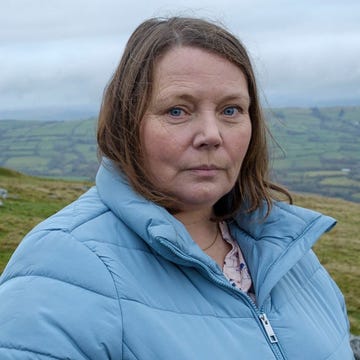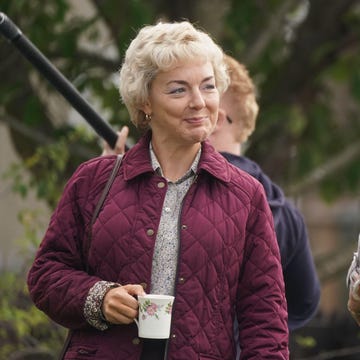I’m sitting in a hospital bed attached to an IV drip, which has been tied to its stand with a rubber glove. A nurse flips through my notes that, for some reason, I’m not allowed to read. She hands me a shot-sized paper cup of tablets. Nobody has explained what dose contains, only that I have to take it. A healthcare assistant peeps through the curtain around my bed with a crusty flannel. ‘Bed bath?’ she asks. ‘No, thank you,’ I say, although my hair feels matted. ‘Bed 3 refusing wash!’, she shouts. It doesn’t matter that my name is Tilly. Here, I’m just ‘Bed 3’.
I was 10 years old when I was first admitted to hospital with a burst appendix. It was terrifying, but it was only the start of my 20-year experience as a ‘medical mystery’ patient. As a teenager, I was in and out of hospital for repeated bouts of pneumonia, with an emergency bowel resection surgery at 16. I was on an endless cycle of appointments, but doctors couldn’t work out what was behind my abdominal problems and recurring pneumonias, which led to a growing list of symptoms affecting multiple systems in my body.
I was shunted between specialists, but they couldn’t put together the full picture. Without a diagnostic ‘label’, I often couldn’t be assigned to a specific department and would be left on a temporary ward unsuitable for long-term stays. On one almost-three-month admission, I watched a system under serious strain as used bedpans piled up around me. There was no blind on the window where I slept and another patient’s name on the board above my bed. I stopped being ‘Tilly Rose’.
I saw first-hand how staff were stretched to the limit. Overworked nurses would be in tears, cleaners would arrive without the products they needed and once, I was handed a pillowcase to dry myself with because no one could find a towel.
It was incredibly sad to see the conditions for staff, but at least they could go home. Patients like me were trapped. I felt like I was in prison, sleeping next to strangers, some of whom were mentally unwell and would try to climb into my bed, confused. On the worst occasion, I witnessed the shocking death of a patient in the bed next to me, who died of a bowel haemorrhage. I was ushered out the room as a pool of blood seeped towards me like a scene from a horror film. And then I was back on the ward, as though nothing had changed. But I had seen death, and I’d never be able to unsee it.
In 2014, I was finally diagnosed with tuberculosis, which I’d been living with for 13 years. We traced it back to drinking unpasteurised milk as a child. At last, it seemed like I had an answer and a path towards better health. I graduated from Oxford University and got my first job in recruitment – a ‘normal’ life. But two years later, I began to deteriorate, culminating in an emergency ambulance admission with a life-threatening adrenal crisis in 2018 (where the cortisol levels needed for organ function drop dangerously low). I was diagnosed with Addison’s Disease, meaning my body couldn’t produce enough cortisol, and discharged with steroid replacements I’d need to take for the rest of my life.
But in 2022, I was back in hospital again, for nearly three months, having violent, hours-long convulsions. It was frightening how predictable the cycle had become. At first, I had teams of people around my bed, saying they’d do everything they could. Then I’d feel the frustration as each line of enquiry dried up. The language would change to ‘your perceived swelling’ or ‘your perceived inability to walk’. I knew that meant the psychiatry department would come next.
There was one NHS doctor who I nicknamed ‘Maverick’, though, as he spent his time off researching my case and thinking outside the box. But there was only so much he could do within the restraints of the system and, in 2022, after almost three months, I was discharged on ‘comfort care’. The consultant told me I should give up and accept this as my life.
In desperation, I turned to my Instagram @thattillyrose. Medics, nurses, PhD students, professors and patients from all over the world got in touch with ideas. My mum went through every suggestion and we noticed that vascular compressions (restrictions in the blood vessels to vital organs) caused many of the symptoms I’d experienced. Mum tracked down an expert to where miraculously, after many more tests, I got a diagnosis.
It turns out I was born with hypermobile Ehlers-Danlos Syndrome (hEDS), meaning I have abnormally stretchy connective tissue. When I unknowingly contracted TB at 14, I lost of lot of weight, which caused my ‘stretchy’ organs and veins to shift into the wrong places and form these vascular compressions. Being undetected for years, my organs had suffered from restricted blood flow, leaving my kidneys struggling to filter toxins from my body and my adrenal glands unable to produce enough cortisol, causing the Addison’s disease. It was a perfectly imperfect storm – but it was the answers I’d been searching for.
My parents sold their house to pay for my treatment in Germany and now, two years later, I’m finally on the path to a healthy life. But I should never have had to go through what I did. I saw first-hand how, when systems are stretched, it’s often the basic level of care and compassion that is lost first. I want to be a voice for other others who’ve struggled through the system, so I wrote a memoir, Be Patient, about my experience. I hope it can bring patients to the forefront of the national conversation and impact care on a wider scale.
My story may seem unique, but we will all be patients at some point in our lives. Whether we’re fighting for ourselves or our loved ones, patient care is something we should all be invested in.












![©ITV from monumental television frauds sr1pictured: jodie whittaker as sam suranne jones as bert this photograph is (c) itv plc/ monumental television and can only be reproduced for editorial purposes directly in connection with the programme or event mentioned above, or itv plc. this photograph must not be manipulated [excluding basic cropping] in a manner which alters the visual appearance of the person photographed deemed detrimental or inappropriate by itv plc picture desk. this photograph must not be syndicated to any other company, publication or website, or permanently archived, without the express written permission of itv picture desk. full terms and conditions are available on the website www.itv.com/presscentre/itvpictures/termsfor further information please contact:michael.taiwo1@itv.com](https://hips.hearstapps.com/hmg-prod/images/frauds-sr1-first-look-03-6891d81c2d536.jpg?crop=0.428xw:0.643xh;0.0641xw,0.116xh&resize=360:*)



